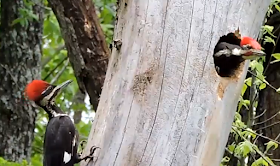 |
| Female Pileated Woodpecker waiting for the next shift to arrive |
 Every 10 to 20 minutes one would stick its head out to look around and maybe to hear any calls. It would look in different directions and sometimes twist its head as though listening intently for its mate. They appeared to be taking 2 hour shifts, probably trading off incubating their eggs, a chore shared by males. The bird to the right is a male, identified by a red streak on the cheek behind the bill.
Every 10 to 20 minutes one would stick its head out to look around and maybe to hear any calls. It would look in different directions and sometimes twist its head as though listening intently for its mate. They appeared to be taking 2 hour shifts, probably trading off incubating their eggs, a chore shared by males. The bird to the right is a male, identified by a red streak on the cheek behind the bill. PWs are uncommonly seen up close. They are a bird of the forest, preferring dense woods with large trees. It is distinctly uncommon to be able to observe them at a nest this close up. We occasionally hear their call across the valley but usually only get a rare glimpse up in the woods. Cornell's All About Birds recordings refer to their "wuk" call but I think the Audibon.org field guide description as a cuk-cuk-cuk is more descriptive. With a long series of calls it tends to rise in pitch, then fall at the end. You can hear one getting its "yucks"at the start of this video that I compiled of the day's highlights.
 |
| Male preparing to leave the nest to the female |
0:00 The male calls and the female sticks out her head to listen. Female flies out of the nest, then the male arrives10 seconds later.
0:33 Male peering out of the nest.
0:54 Female arrives and they trade places
1:45 Female leaves and male returns
 |
| Airborne! |
- Of course someone has studied the difference between woodpecker tail and body feathers as seen here.
- The Infinite Spider goes into the anatomic features allowing woodpeckers to hammer at 1000x the force of gravity.
- Thenaturalistsnotebook.com has a set of incredible photographs of a pileated woodpecker at work.
 |
| "I'll be back in an hour!" |